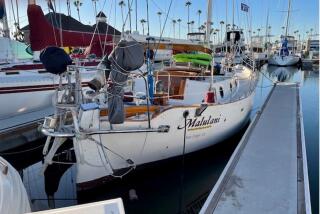Yachting on Someone Else’s Nickel
- Share via
At 21, Greg Becker was lucky enough to do many of the things that most young people only dream about--surf on tropical beaches, explore long-lost shipwrecks, witness the wildlife of Africa--and he traveled around the world for next to nothing. Now he’s written a book to help other like-minded adventurers.
Becker joined on as a crew member on ocean-going yachts. He spent the better part of three years circling the globe almost twice.
While working in a dockyard in California, he connected with a family looking for assistance with sailing their 97-foot vessel. The relationship was a good one, and after the first year he was made captain. He spent almost two years with the family and covered 35,000 miles, visiting 42 countries. Eventually he was even able to arrange for two high-school buddies to join the crew.
Not every arrangement is as ideal, but with the right information and skills, good opportunities to travel do exist.
“The Seagoing Hitchhiker’s Handbook: Roaming the Earth on Other People’s Yachts,” covers the skills that would make you most desirable, such as pre-trip planning, money matters, where to look and when, what to consider before signing on, captain and crew relationships and a listing of the best-traveled cruising routes.
The handbook describes how ship owners are influenced by the weather to travel known routes during certain seasons. This is the kind of information that’s invaluable to would-be crews. Being in the right place at the right time, with some desirable skills (seamanship, cooking, engine repair or coastal navigation) puts you in the strongest position.
You’ll also learn that although you might be lucky enough to travel for next to nothing, you can’t count on it. Some owners require crews to contribute to a food kitty. Because you are not traveling with a round-trip plane ticket, you may also need to have money available for posting a bond (i.e. $1,500 in the South Pacific), which is refundable when you leave a country. This ensures a country, especially one such as Tahiti, that you will indeed go home and not become a beach bum.
The most frequent question Becker is asked? How safe is this for women?
After talking with women who have traveled this way, he offers the following suggestions:
* The best arrangements to look for are ships sailed by families or couples.
* Don’t pick a ship that has you heading right out to sea. Try to hook up with one that is traveling down a coast first so there are ports and opportunities to change your plans if you are not comfortable.
* Before you commit, pay attention to where the ship is going to wind up. You should try for a ship that is going to leave you at another busy port, so you’ll have the opportunity to be choosy about whom you’ll join up with for the next leg of your journey.
Becker never really had a bad experience, but he attributes this in part to trusting his gut. There was a time when he was in New Zealand and was approached by a woman looking for crew. Although he couldn’t put his finger on a problem, he just wasn’t comfortable and decided to pass. Several years later on a beach in California, oddly enough, he met the man who had signed on instead of him. It had been a terrible journey, in tight quarters with an owner with unpredictable behavior. The crew had departed at first opportunity.
“There are lots of opportunities, so you should be able to filter out the bad situations,” Becker says. Erring on the side of caution is wise though. You want to be sure that you won’t be crossing any borders with illegal goods that you could be held responsible for.
You can order “The Seagoing Hitchhiker’s Handbook: Roaming the Earth on Other People’s Yachts,” by calling High Adventure Publishing at (800) 352-6657. The price is $11.95 plus $3.50 for shipping.
More to Read
Sign up for The Wild
We’ll help you find the best places to hike, bike and run, as well as the perfect silent spots for meditation and yoga.
You may occasionally receive promotional content from the Los Angeles Times.






